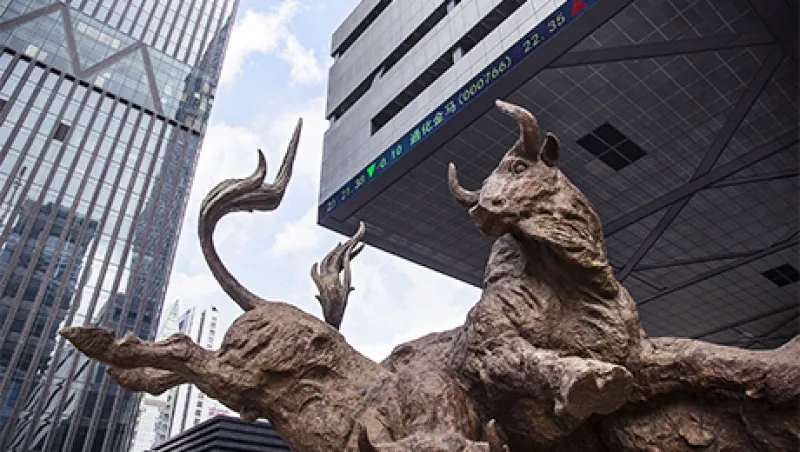Index provider MSCI announced it will dramatically boost its emerging markets exposure in light of positive market reforms in major markets such as China and Saudi Arabia.
The New York-based company, which is closely followed by institutional investors, issued a release at the market close on Tuesday announcing that it will include China-listed A shares in its benchmark Emerging Market Index for the first time. At the same time, the company said it also will put shares listed on the Saudi Arabia Stock Exchange on a watch list for inclusion.
The inclusion of 222 China A Large Cap equities will be reflected in the index in June 2018, according to MSCI, which also noted that a successful review of the Saudi markets at that time could result in inclusion of a number of equities listed on that exchange.
Fund managers in Asia applauded MSCI’s decisions, particularly the China move, and predicted that global inflow of institutional money into the Shanghai and Shenzhen exchanges could rise dramatically in the coming five years.
Qi Wang, an asset manager with MegaTrust Investments (HK), predicts China’s stock markets could reach up to $640 billion in new capital from foreign investors once MSCI accounts for much of the A-shares market in China in the coming few years.
“A-shares could account for 20 percent of emerging markets, and China as a whole could become 40 percent of emerging markets by market capitalization,” predicts Wang, the chief executive officer of MegaTrust, which manages $500 million on behalf of global institutional clients. “Expect a paradigm shift in global and Chinese equity markets accordingly.”
MSCI’s decision to include A shares comes after three previous rejections due to market access restrictions and is a game-changer for Chinese equity markets. Previously, the index provider listed only offshore listings of Chinese companies, primarily Hong Kong and New York-listed equities. Collectively, the offshore listings made up only about 27 percent of the emerging-markets index.
Khalid Abdullah Al Hussan, chief executive officer of the Saudi Stock Exchange, also known as the Tadawul, also welcomed MSCI’s decision to put that market on a review for inclusion.
“We are very excited about the announcement today,” Al Hussan says. “We will continue to be transparent and open to integrating with the rest of the international community.”
MSCI’s announcement follows Tadawul’s successful completion of its transition to a T+2 settlement cycle for all listed securities, which went into effect on in April. The move came just a year after the Saudi Capital Markets Authority granted Tadawul regulatory approval to amend the settlement cycle to two subsequent business days from the trade execution date.
The move to T+2 is the latest step the exchange has taken to further align the Saudi capital market with international standards and make it more attractive to both domestic and foreign investors. The transition increases the level of asset safety for investors by providing enough time to verify trades and unifies the settlement duration for all types of listed securities across most international markets.
In conjunction with the launch of T+2 settlement, Tadawul also introduced securities borrowing and lending and covered short selling, and it is the first market in the Middle East to offer stock lending and covered short selling for all listed stocks.
MSCI noted that it will delay inclusion into the emerging markets index equities listed on the Argentinan and Nigerian exchanges, however, pending more reforms in those markets.
Victoria Mio, a fund manager for Chinese equities and chief investment officer for China at Japanese owned asset manager Robeco, joined the chorus of investors praising MSCI’s moves.
“The A-share market offers investors access to themes that are not so well-represented in the offshore universe,” says Hong Kong-based Mio. “Some of these sectors that make up the ‘new economy,’ like healthcare, mass market consumer products, services and technology, are showing better growth than the market as a whole.”
China’s Shanghai and Shenzhen exchanges together have a market capitalization of more than $7 trillion. Adding in Hong Kong’s $3.6 trillion market cap, China’s exchanges form a $11 trillion market, behind only those in the U.S., which are still considerably ahead at $26 trillion.
“We are positive on the outlook for China’s A-share market,” Mio adds, noting that earnings in China’s corporate sector are on an upward trend. In the first quarter of this year, A shares’ combined earnings rose 21.5 percent over the same period in 2016, the second-highest single quarter growth since 2010. Mio also notes that estimates for 2017 earnings growth are also strong, with 19 percent and 38 percent upside over 2016 expected for Shanghai and Shenzhen stocks, respectively.
Over the past two years, Chinese regulators have launched two so-called stock connect programs that give all investors in Hong Kong, including foreign fund managers, access to trade equities listed in Shanghai and Shenzhen. The programs, which also allow Chinese investors in those markets to trade Hong Kong-listed equities, were key reasons that MSCI opted to include A shares, Sebastien Lieblich, MSCI’s Global Head of Index Management Research, said in a conference call announcing the news.
“The vast majority of institutional investors welcome the stock connects,” said Lieblich, adding that the allocation could go up in the next few years if Chinese regulators expanded or lifted current daily trading quotas. At present, regulators cap offshore purchases of A shares at 13 billion yuan ($1.9 billion) and onshore purchases of Hong Kong shares at 10.5 billion yuan.
Regulators in China and Hong Kong launched the Shanghai-Hong Kong Stock Connect in late 2014 and the Shenzhen-Hong Kong Connect in early 2016. Over the past year, daily quotas were widened substantially.






